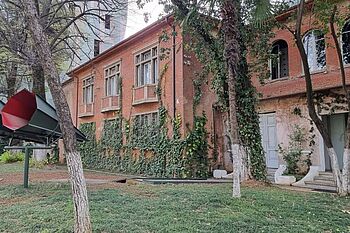The House of Leaves

Credit: Leonie Buche
From the outside, one might mistake it for a bourgeois villa. However, the red brick walls of this building actually concealed the surveillance headquarters of the Albanian secret police. For decades, the Sigurimi monitored the telephone connections of diplomats, politicians and celebrities from here. The building in downtown Tirana is now a museum. It was curated by the son of a politician – a writer who was unjustly imprisoned in Albania for eight years.
The villa-like building was originally built in 1931 as the first private maternity clinic in Albania. After the communists came to power, their secret police moved in here in 1944 – and stayed until 1991. The Tirana telephone exchange was located right next door, so it was easy to tap into its cables and listen in on telephone conversations from here. The two-story structure also housed other technical units of the Sigurimi, including a photo lab where surveillance photos were developed.
The building stood empty for a long time after the end of the communist dictatorship. As it became overgrown with ivy, it acquired the name "House with Leaves." New multi-story buildings were constructed all around it, but the historically and architecturally important building was designated a landmark and preserved. Prime Minister Edi Rama eventually instructed his culture minister to turn it into a museum that opened in 2017. It was awarded the Council of Europe Museum Prize three years later.
The museum concept was created by the son of the long-time communist prime minister Mehmet Shehu. Bashkim Shehu was arrested after the death of his father who, as minister of the interior, had been head of the Sigurimi until 1954 and responsible for ordering numerous executions. When he was found dead in his bedroom with a bullet wound to his head in 1981, it was officially ruled a suicide. But Hoxha subsequently framed him as a Yugoslav, U.S. and Soviet spy and had his widow and two of his sons arrested. His wife died in prison and one of their sons committed suicide. The other son – who later curated the museum – was sent to the Spaç labor camp where he remained until his release in 1989. These events are the subject of the novel The Successor by Ismail Kadaré.
The museum is dedicated to both the history of the building and the methods of the Sigurimi. Rather than basing its presentation on scientific documents as is done in similar institutions in other countries, it takes a more artistic-associative approach to the history. The staircase and windows, for example, are printed with stylized leaves. One room contains a surveillance camera whose recorded images are projected in another room. The garden contains oversized funnels symbolizing how the city of Tirana was wiretapped from here (see photo). Only a few of the 31 rooms have been preserved in their original state.
Links
Website of the House of Leaves Museum
Short video about the House of Leaves Museum
Council on Europe awarding prize to the House of Leaves Museum
After the Dictatorship. Instruments of Transitional Justice in Former Authoritarian Systems – An International Comparison
A project at the Department of Modern History at the University of Würzburg
Twitter: @afterdictatorship
Instagram: After the dictatorship
With financial support from the German Federal Ministry for Economic Cooperation and Development
Shkodër Memorial
![[Translate to Englisch:] Shkodre Museum](/fileadmin/_processed_/a/6/csm_Shkodre_Museum_Zellengang_5e791826bf.jpg)
The renovated cell doors in the "Site of Witness and Memory" – as the memorial in Shkodër in northwestern Albania calls itself – have a far too shiny glow to them. The memorial is located in a former remand prison of the Albanian Ministry of the Interior. For more than four decades, political prisoners were detained and tortured here. It is the only memorial site in Albania dedicated to the victims of the communist regime.
The building, built as a private home in the 19th century, served for many years as an orphanage and hospital. In 1930 the Franciscan Order began using it as a preparatory college for aspiring priests. In 1946 the communist government confiscated the house and established it as the regional headquarters of the Ministry of the Interior. The monks' cells were converted into interrogation cells that were used until 1992.
Until the end of the Second World War, Shkodër was the center of Albanian Catholicism. It was the seat of the archdiocese and bishopric and home to several Catholic schools and religious orders. The communist regime targeted Catholic dignitaries in particular for persecution. Sixty-one clergymen alone in Shkodër were executed, and many more were imprisoned, often for decades. The police and Sigurimi confiscated 26 buildings previously used by the religious followers and converted the cathedral into a gymnasium. In November 1990, after the 20-year ban on religion was finally lifted, the first public religious service was held in the old Catholic cemetery.
This unusual story of persecution is presented in the entrance hall of the museum, which opened in 2014. In addition to a general map showing all the prisons in the city, the exhibition presents objects from the prison as well as manuscripts and letters from prisoners and their families. Several official documents are also displayed. A tunnel made of red arches leads to the former detention area with the 23 cells that only received daylight through a small opening. The courtyard of the former prison is also accessible to the public. The museum only receives a small amount of funding from the local government.